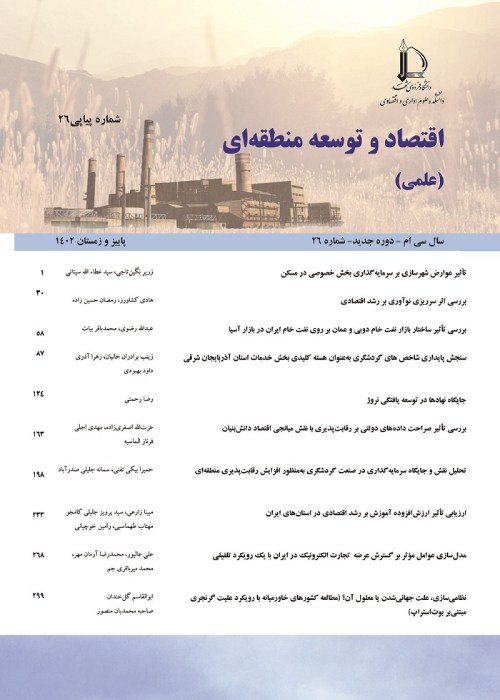Introduction and Evaluation of Industry-Specific FLQ Method to Regionalization of National Input-Output Tables: A Case Study of Yazd Province in 2011
Author(s):
Abstract:
Introduction
Today, the importance of economic planning and predictions in the development of different countries, especially developing countries, is obvious to anyone. Due to the application of input-output tables in cases such as identification and forecasting the needs of the labor and energy market, analysis of economic structure and its changes, identifying the leading (key) sectors and analyzing intersectoral dependencies, the role of these models in development planning has been highlighted.In the past decades, introducing the concept of regional planning and applications of the input-output model in this context have led researchers and policy-makers to consider regional input-output tables more seriously. Due to the fact that survey-based method for providing input-output tables is expensive and time-consuming and with regards to the weakness of regional data in Iran, non-survey based methods, especially location quotient (LQ), are the most common methods for providing regional input-output tables in Iran. In recent years, LQ method and its various functions has significantly evolved and SFLQ function has recently been introduced. The aim of this study is introducing the most popular LQ functions (with emphasis on SFLQ) and providing a method for evaluation of their performance in regionalization of national input-output tables (the case study of Yazd province). For this purpose, the national input-output table of parliament research center in 2011 was utilized. Based on empirical studies in this field, flegg location quotient functions, which include FLQ, AFLQ and SFLQ have a significant advantage when estimating regional coefficients compared to other LQ methods. The current study evaluates flegg location quotient functions.
Methodology
Compiling regional input-output tables with the use of LQ methods is done based on two basic principles. Firstly, it is generally true that the smaller the economic area, the more dependent that areas economy on trade with outside areas transactions that cross the regions borders both for sales of regional outputs and purchases of inputs needed for production (Miller & Blair, 2009: 69). Secondly, all LQ methods are based on this assumption that regional and national technologies are identical and that regional trade coefficients differ from national input coefficients to the extent to which goods and services are imported from other regions (Kowalewski, 2015: 242). Given these two points, the role of LQ adjustment coefficient is to take account of a regions purchases of inputs from other regions in the nation.An important issue that is challenging to the use of flegg LQ, is the selection of optimal values for the unknown parameter δ in this formulas. In the absence of regional survey-based table, choosing this value is very challenging. In this study, to determine the optimal values of δ and δj in flegg LQ methods and evaluating their performance, the proposed method by Bazzazan et al (2007) has been modified. In this method for each δ value, one regional input-output table will be calculated. Then, the supply-driven Ghosh coefficients will be calculated and using the value added data of the province economic sectors, which is available in the regional accounts of Statistical Center of Iran, the output of each sector will be estimated using the related formulas. In the next step, a value of δ, which minimizes the statistical errors caused by the difference between real and estimated outputs, will be selected as the optimal value.
Results And Discussion
The results of the current study show that based on different statistics, FLQ and AFLQ Methods used to estimate the Yazd province table have similar performance. However, the SFLQ partially improved the performance. Moreover, SFLQ has a different performance when used to calculate forward and backward linkages compared to other methods. In FLQ and AFLQ, the only sector with forward and backward linkages larger than one is "manufacture of chemicals, coke and refined petroleum products". Nevertheless, this sector with an SLQ of .11, is one of the smallest non- specialized sectors in Yazd province. The table derived from the SFLQ method, demonstrates that sectors of "manufacture of rubber and plastics products" and "manufacture of electrical and office machinery", which are specialized sectors in Yazd province (SLQ> 1), have forward and backward linkages larger than one.The optimal values of δ and δj as expected are very high. Therefore, the optimal value of δ based on all statistics is .999, the maximum value possible. The optimal value of δj is very high for most sectors as well.
Conclusion
It is expensive and time-consuming to produce a table based on a survey of establishments in a particular economy, both at national and regional level. This problem, in addition to the insufficiency of data in Iran has caused the use of location quotient method as a non-survey based method in Iranian Studies. However, few studies have evaluated the performance of these method formulas. The aim of this study was introducing the most popular LQ functions (with emphasis on SFLQ) and evaluation of their performance in regionalization of national input-output tables (the case study of Yazd province). For evaluation of these functions performance, a method based on modification of Bazzazan et als (2007) method was presented. The results show that FLQ and AFLQ Methods have a similar performance both in term of estimation of output and calculation of forward and backward linkages, when preparing the input-output table for Yazd province. However, the SFLQ has partially improved their performance.Keywords:
Language:
Persian
Published:
Journal of Economy and Regional Development, Volume:24 Issue: 13, 2017
Page:
112
magiran.com/p1757978
دانلود و مطالعه متن این مقاله با یکی از روشهای زیر امکان پذیر است:
اشتراک شخصی
با عضویت و پرداخت آنلاین حق اشتراک یکساله به مبلغ 1,390,000ريال میتوانید 70 عنوان مطلب دانلود کنید!
اشتراک سازمانی
به کتابخانه دانشگاه یا محل کار خود پیشنهاد کنید تا اشتراک سازمانی این پایگاه را برای دسترسی نامحدود همه کاربران به متن مطالب تهیه نمایند!
توجه!
- حق عضویت دریافتی صرف حمایت از نشریات عضو و نگهداری، تکمیل و توسعه مگیران میشود.
- پرداخت حق اشتراک و دانلود مقالات اجازه بازنشر آن در سایر رسانههای چاپی و دیجیتال را به کاربر نمیدهد.
In order to view content subscription is required
Personal subscription
Subscribe magiran.com for 70 € euros via PayPal and download 70 articles during a year.
Organization subscription
Please contact us to subscribe your university or library for unlimited access!



